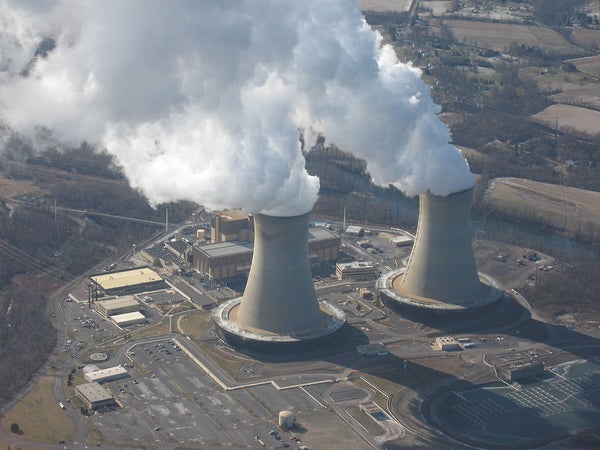This article was published in Scientific American’s former blog network and reflects the views of the author, not necessarily those of Scientific American
In the wake of President Donald Trump’s announcement that he was withdrawing the United States from the international climate agreement, governors from over a dozen states immediately announced they would take climate action on their own.
There is much that governors and state legislators can do, but studyafter study finds that keeping existing nuclear plants—our largest and most reliable source of clean energy—operating is one of the most important and cost-effective ways to prevent carbon emissions from increasing.
Over the last three years five nuclear plants were closed prematurely in states including Vermont and California and were replaced almost entirely with natural gas, which increased emissions.
On supporting science journalism
If you're enjoying this article, consider supporting our award-winning journalism by subscribing. By purchasing a subscription you are helping to ensure the future of impactful stories about the discoveries and ideas shaping our world today.
Now, half or more of all American nuclear plants are at risk of being closed prematurely over the next decade and a half, according to research by Bloomberg New Energy Finance and Environmental Progress.
The main reason is that the fracking revolution has delivered a surplus of cheap natural gas. That’s delivered cheaper electricity and lower emissions when it replaces coal plants. But it’s also made nuclear plants, particularly smaller ones in states that deregulated wholesale electricity markets, uncompetitive.
But another reason for nuclear’s woes is that it is excluded from most state and federal subsidies for clean energy, which is why solar and wind have boomed during a time of low natural gas prices.
A recent study by the nonpartisan federal Congressional Budget Office found that renewables received 114 times more than nuclear per unit electricity in 2016, and similarly high amounts since 2005.
And over 30 states, including those whose governors criticized Trump, have clean energy mandates that exclude nuclear.
Even today’s fracking revolution is a product of federal subsidies. Between 1978 and 2007, the federal government invested $24 billion on fossil energy research that led to the fracking revolution—including $10 billion in tax credit subsidy for “unconventional” oil and gas drilling.
Nuclear received funding for research and development in the 1950s, but solar, wind and fossil fuels received similar amounts in the decades since.
While solar and wind have expanded significantly in recent years, they still provide only six percent of total electricity compared to nuclear’s 20 percent, and they do so unreliably.
And where solar and wind only provide 10 to 30 percent of their rated power during the year, depending on location, nuclear reliably provides electricity day and night, rain or shine, for over 90 percent of the year.
Making matters worse, perverse incentives created by subsidies for wind have forced nuclear plants in states like Illinois to pay penalties for producing electricity at times when the grid is at risk of being overloaded by huge surges of electricity from wind, often in the middle of the night when it’s not needed.
And while batteries have become cheaper, they are still too scarce and expensive to back up solar and wind farms. Just to store 10 percent of the electricity created during the day by one of the largest solar farms in the world, Topaz, in California, would require 62,000 Tesla’s 6.4kWh Powerwall batteries. Tesla’s first quarter sales in 2016 totaled 2,500.
What that means is that solar and wind cannot replace fossil fuels and, worse, risk locking-in natural gas, which is needed to quickly replace lost solar and wind generation when the wind stops blowing and the sun stops shining.
Over the long-term, Congress should implement a tax on carbon emissions, and return the money to ratepayers. Such an approach would create a strong incentive and level playing field for all forms of clean energy. And it would give all Americans, even ones skeptical of climate change, reason to support aggressive action.
In the meantime, governors who are outspoken advocates for climate action must act to protect nuclear plants which, once closed, cannot be started back up.
Last year, the two of us and dozens of other scholars and scientists urged the legislatures and governors of Illinois and New York to recognize nuclear plants for their environmental benefits. Both states eventually did so, and at a lower cost per unit of electricity than the subsidies given to wind and solar.
Now, it’s time for other states including California, Ohio, Connecticut, Pennsylvania, and New Jersey—whose governors have criticized President Trumps withdrawal from the Paris agreement—to follow, and match their strong words with even stronger action.
